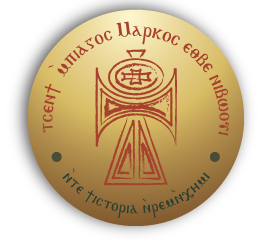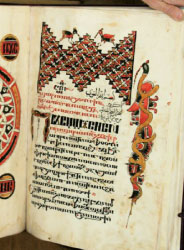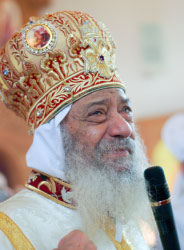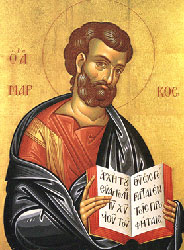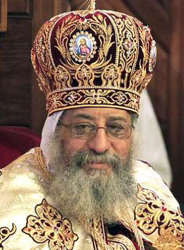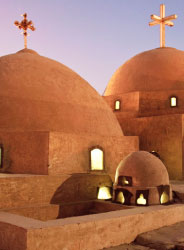St. Mark Foundation for Coptic History Studies

Its Inception:
The idea of establishing the Foundation first occurred in end of 1997 to Dr. Fawzi Estefano, who lives in the United States. He put the idea to His Holiness the Pope Shenouda III, who approved it and give it his official “blessing” on 23/2/1998. His Holiness also generously provided the Foundation with an office in the Coptic Studies Institute building in the Anba Ruweis complex in Cairo to enable it to carry out its activities in Egypt and to fulfill the purpose for which it was founded, which the Pope’s blessing states as follows:
“This Foundation shall carry out thorough research and collect complete and documented information on Coptic history since the coming of Christianity to Egypt up to the present. Its studies will include all the areas of Coptic history, embracing all the references it can obtain in the libraries and museums in Egypt and abroad.
The Foundation has to publish its research and books on a regular basis and in a systematic way to ensure that they are available to the greatest number of individuals, churches, libraries, organizations, and to our colleges and religious institutes. The Foundation is to be a definitive resource and reference for Coptic history.”
His Holiness also exhorted all the Bishops and prelates of the Church, the clergymen and professors in the Seminary and in all its branches in Egypt and in the West, and all those concerned with Coptic studies to offer all the facilities they have so that this project might succeed and be to the building and consolidation of our Holy Church.
The Editorial Board of the Foundation has accomplished the following:
- It issued its first publication, which was a reprint of The History of the Coptic Nation by the well known author Yacoub Nakhla Rufaila on the occasion of the centenary of its first publication in 1898. This is an important reference work and a source frequently used by the renowned historian, Dr. Aziz Surial in his many writings.
- His Holiness the Pope Shenouda III also entrusted the Foundation with the manuscripts found in the Anba Beshoy monastery in Wadi Al Natrun, and charged it with their restoration, photographing, categorizing, and documenting in a catalogue to be published. This is an ongoing project and will be part of a more extensive undertaking which will include other manuscripts as they become available, both here and abroad with the aim of obtaining a comprehensive and complete catalogue of all the Coptic manuscripts in Egypt and the world.
- The Foundation published the first of its series, The Dioceses of Egypt and their Coptic Relics. This was entitled Christian History and Antiquities in Aswan and Nubia by the renowned historian, Mr. Nabih Kamel, and the professor of antiquities, Mr. Atef Nagib.
- The Foundation undertook the printing and publication of its first English book on the life of the Apostle Mark by the Coptologist, Dr. Samir Fawzi Guirguis, entitled A Chronology of St. Mark.
- It printed and published its second book, Coptic Culture and Literature, by Father Shenouda Maher Ishak and Dr. Youhanna Nessim Youssef, professor of Coptology in Australia. This book gives an account of the sources of Coptic literature and culture as well as a thorough exposition of the history of the Coptic language and dialects. It also includes an up to date bibliography of Coptic literature.
- The second book in the series on the history of the dioceses in Egypt was published and is entitled Christian History and its Antiquities in Pentapolis by Archdeacon Dr. Mikhail Maxi Iskander and with a preface by His Grace Metropolitan Pakhomious, This is the first complete reference on Pentapolis.
- This was followed by the third book in this same series, Christian History and Monasticism in the Southern Dioceses of Shouhag and Akhmeem, by Mr.Nabih Kamel Daoud, Professor of Coptic history, Dr. Sameh Shafik, and Dr. Adel Fakhry, both respected Professors of Coptic antiquities.
- The fourth book published in that series is entitled Christian history in the Diioces of Luxor, Naggada, and Qus by the historian Mr. Nabih Kamel and the professor of Coptic antiquities, Dr. Adel Fakhry. The introduction to the book was written by His Grace, Bishop Youannis, secretary to His Holiness Pope Shenouda III.
- A fifth book in the series was also published dealing with the diocese of Giza and its environs also authored by Mr. Nabih Kamel and Dr. Adel Fakhry, with an introduction by His Grace Bishop Theodosius.
- The sixth book in the series on Assiut is in the process of publication. His Holiness Pope Tawadros II has charged the Foundation with the organization of an international conference on St. Mark the Apostle to be held in the Cathedral and which
- His Holiness will inaugurate. This conference will celebrate the fiftieth anniversary of the Cathedral and the Foundation will collaborate with other concerned parties in the Cathedral in organizing it.
- At the instructions of his Holiness the Pope Shenouda III, the Foundation recorded 350,000 titles and 760,000 pages of manuscripts, almost 40% of the Coptic manuscripts abroad, on 16 Cds which his Holiness presented to the Alexandria Library on the occasion of his first historic visit on 23 February 2003.
- Charged by His Holiness Pope Shenouda III, the Foundation had the honor to oversee the project of establishing the Coptic Cultural Center, which is to house the St. Mark Public Library of the Coptic Church in the new Social Services building in the Anba Ruweis complex. It was inaugurated by His Holiness Pope Shenouda III on 14 November 2008.
- With the blessing and support of His Holiness Pope Tawadros II, the Foundation has begun its huge undertaking of photographing, documenting, and recording all the Coptic Orthodox monasteries and churches throughout Egypt starting 2013.
-
The Coptic Encyclopedia, after revision, will soon be recorded on CDs and made available to a wide audience at little cost. In addition, St. Mark Foundation for Coptic History Studies has held several biennual Scientific and International symposia on the history of Coptic monasticism.
- The first was held from 31 January to 5 February, 2002 in Wadi al Natrun and it dealt with the region of Coptic Monasttries in Wadi el Natrun and was hosted and inaugurated by his Holiness Pope Shenouda III in his papal residence in the monastery of Anba Pshoy. This symposium was attended by 22 Egyptian and foreign participants from 11 different countries. The proceedings of the symposium were published in English in a book entitled Christianity and Monasticism in Wadi al Natrun, and was prepared for publication by Magued Mikhail and Mary Moussa.
- The second symposium was held in February 2004 ( 6 – 10 ) and dealt wuth the history of the Monastries of ancient Fayoum. It was hosted by His Grace Bishop Abram, bishop of Fayoum and its environments and Abbot of the monastery of Al Azab. – after having the approval of H.H. Pope Shenouda 111 - 27 Coptologists from various countries attended and the proceedings were published in a book entitled Christianity and Monasticism in the Fayoum oasis, edited by Dr. Gawdat Gabra and Mr. Hany Takla.
- The third symposium dealt with the area of Souhag and Akhmeem and was held in February 2006. ( 1 - 6 ) It was hosted by His Grace Bishop Youannis, Abbot of the monastery of Anba Shenouda. The proceedings were published In Christianity and Monasticism in Upper Egypt, Vol. 1, Akhmim and Sohag - edited by Dr. Gawdat Gabra and Mr. Hany Takla.
- The fourth symposium covered the area of Naggada and Qus and was held in the monastery of the Archangel Micheal in Naggada in February 2008 ( 6 – 11 ), hosted by his Grace Anba Beiman. The proceedings were published in Christianity and Monasticism in Upper Egypt, Vol 2, - Nag Hammadi – Esna - edited by Dr.Gawdat Gabra and Mr. Hany Takla.
- The fifth symposium was held in the monastery of Anba Hedra in Aswan and covered the Monastriesin the area of Aswan and Nubia. It was held in February 2010 – ( 31 January – 4 Fef. ) and was hosted by His Grace Metropolitan Hedra,
- His Holiness Pope Tawadros II honored us by opening the sixth symposium on the monasteries of Assiut. This was held under the auspices of His Grace Metropolitan Mikhail, of Assiut and was generously hosted by His Grace Bishop Severus in the Muharrq monastery in February ( 4 – 8 ) The proceedings are being prepared for publication.
- Delegations from the Foundation attended the International Coptic Conferences held every 4 years in one of the cities of the world. They attended the meeting held in Holland in 2000 and the one held in France in May 2004. At the latter, the Foundation, acting on the instructions of His Holiness Pope Shenouda III, extended an invitation to the organizing committee to hold their 2008 meeting in St. Mark’s Cathedral in Anba Ruweis. In collaboration with the Coptic Studies Institute and the Bishopric of Social Services, the Foundation organized this successful and well attended meeting – ( 14 – 18 September ). It also sent a delegation to attend the September 2012 meeting in Rome.
- With the approval of His Holiness Pope Tawadros II, the foundation will be holding its seventh symposium in King Mariut in February 6 & 7 2015., which will be hosted by His Grace Bishop Kyrollos, Abbot of St. Mena’s monastery.
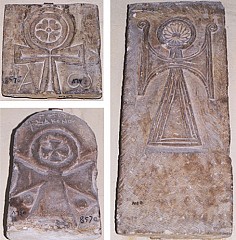
Roots of St. Mark Foundation Logo
Coptic sculptures with the looped cross 6th and 7th centuries
The looped cross derives from an ancient Egyptian hieroglyph, the ankh-sign. In 391 when Patriarch Theophilus ordered the razing of the Serapeum in Alexandria, many examples of the hieroglyph were still to be seen on its walls. A dispute between Christians and pagans ensued over the symbol’s reference, with the Christians asserting its meaning as the Lord’s cross. In fact the Copts had ‘Christianized’ the sign somewhat earlier in the fourth century.
In the ancient Egyptian hieroglyphic script, the ankh-sign was used to write the noun ‘life’ and the verb ‘to live.’. In Coptic art the looped cross appears in various techniques and media—on tombstones and in architectural sculpture, in textiles, manuscript illumination, metalwork, and even ceramics.


